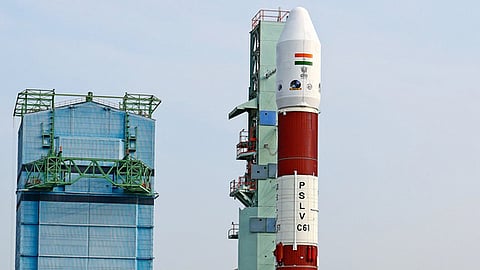

BENGALURU: By the time you are reading this, if all parameters have worked well, India will have achieved the significant milestone with the Indian Space Research Organisation’s (ISRO’s) 101st mission, having launched a more sophisticated eye in the sky — the earth observing satellite EOS-09 — on board the launcher PSLV-C61 from the First Launch Pad (FLP) at Satish Dhawan Space Centre, SHAR, at 5.59 am earlier this (Sunday) morning.
The mission will place the EOS-09 into a Sun Synchronous Polar Orbit (SSPO) at an altitude of about 530 Km. SSPO is a polar orbit ensuring that the satellite remains in the same position relative to the sun and passes over a specific point on Earth at the same local time of day, consistently.
The mission carries a Synthetic Aperture Radar (SAR) payload, capable of providing images for various earth observation application under all-weather condition, and is capable of earth observation through clouds as well as in the dark at night.
An SAR is a remote sensing technique employing radar signals to create high-resolution images of terrestrial features, unaffected by thick clouds, whether it’s day or night, or any weather condition presented. It is of high value for applications like environmental monitoring, emergency response, as well as in military reconnaissance.
ISRO said the EOS-09 is a repeat satellite of EOS-04, with a mission life of five years and designed with the objective of ensuring remote sensing data for the user community engaged in operational applications and to improve the frequency of observation. The spacecraft is configured using ISRO’s RISAT-1 heritage bus, with most of the functional requirements of the SAR payload and the bus platform systems derived from the earlier ISRO missions.
The spacecraft is configured using ISRO’s RISAT-1 heritage bus, with most of the functional requirements of the SAR payload and the bus platform systems derived from the earlier ISRO missions.
“After EOS-09 is deployed, Orbit Change Thrusters (OCT) will be used to reduce the altitude of the PS4 stage, followed by passivation to limit its orbital life — a step aligned with responsible space operations. The EOS-09 is designed to provide continuous and reliable remote sensing data for operational applications across various sectors,” said ISRO in a release here.
PSLV-C61 marks the 63rd flight of the Polar Satellite Launch Vehicle and the 27th using the PSLV-XL configuration. This mission continues the PSLV’s record of delivering reliable performance across a wide range of payloads and orbits.